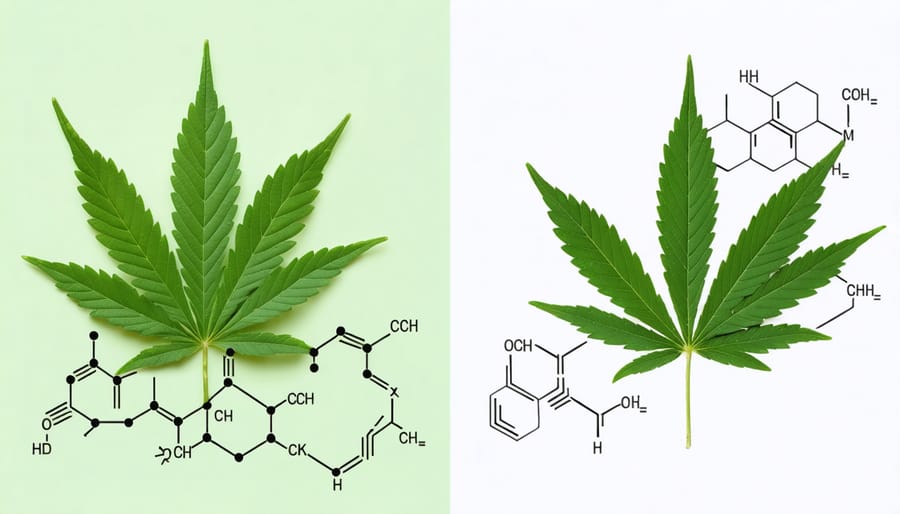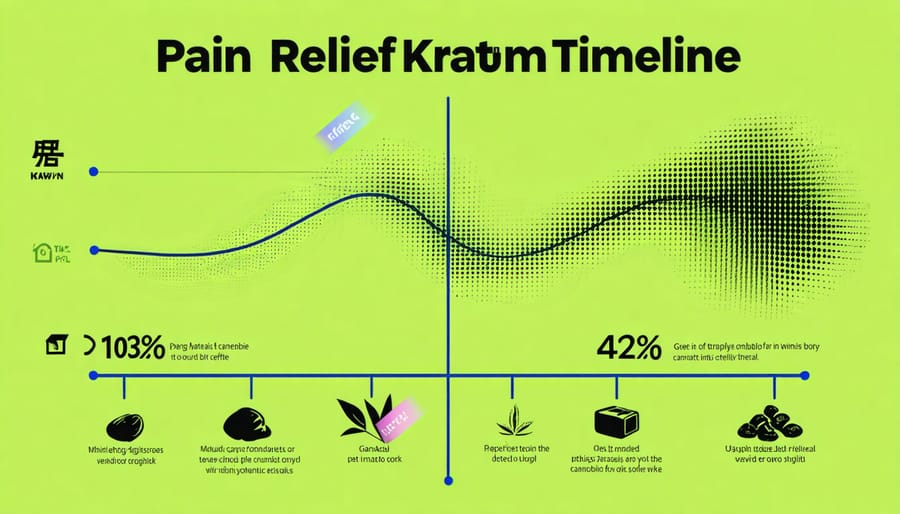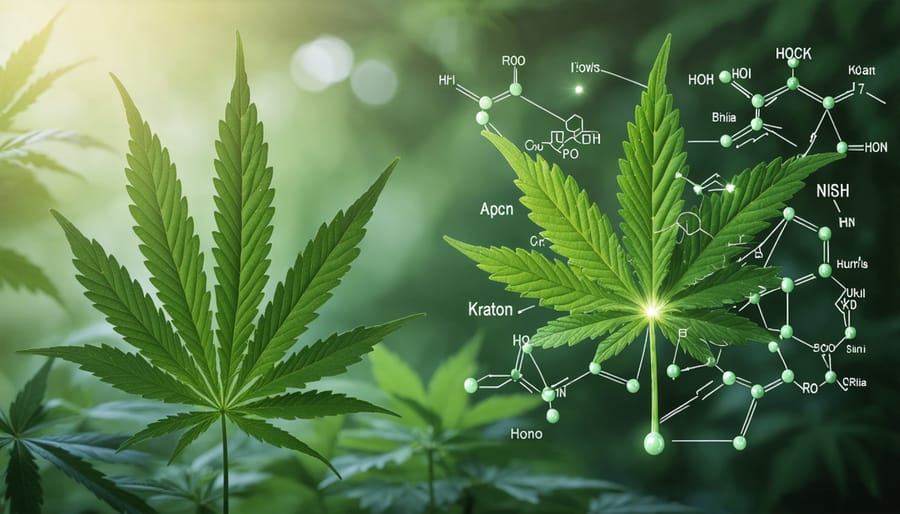Natural alternatives for wellness have gained significant attention, with High Quality Maeng Da Kratom and cannabis emerging as two prominent options in the Canadian therapeutic landscape. These botanical substances offer distinct benefits for managing pain, anxiety, and mood disorders, yet their effects and applications differ substantially. While cannabis has established itself through extensive research and legal frameworks, kratom’s traditional use spans centuries in Southeast Asia. Today’s growing interest in holistic health solutions demands a clear understanding of how these plants compare – from their mechanism of action to their safety profiles and therapeutic potential. This evidence-based exploration cuts through the misconceptions, examining how each substance might serve different wellness needs while acknowledging the importance of informed, responsible use within Canada’s regulatory environment.
The Science Behind Kratom and Cannabis

Key Compounds and Effects
While cannabis and kratom share some similarities in their effects, they work through distinctly different compounds. Cannabis primarily operates through cannabinoids, with THC and CBD being the most well-known. These compounds interact with the body’s endocannabinoid system, which regulates mood, pain sensation, and various physiological processes. Many users find relief through various CBD products that offer therapeutic benefits without psychoactive effects.
Kratom, on the other hand, contains alkaloids like mitragynine and 7-hydroxymitragynine. These compounds primarily interact with opioid receptors in the brain, though their effects can vary significantly based on dosage. At lower doses, kratom typically produces stimulating effects, while higher doses tend to be more sedating.
The key distinction lies in their mechanism of action. Cannabis compounds work through a complex network of receptors throughout the body, potentially offering a broader range of effects. Kratom’s alkaloids target specific receptor sites, resulting in more focused effects. This difference explains why some users might find one substance more suitable than the other for their specific needs, whether seeking pain relief, mood enhancement, or relaxation.
Interaction with Body Systems
Both kratom and cannabis interact with the body’s systems in distinct ways. Cannabis primarily works through the endocannabinoid system, binding to CB1 and CB2 receptors throughout the body. These receptors are found in the brain, nervous system, and immune cells, which explains cannabis’s wide-ranging effects on mood, pain perception, and inflammation.
Kratom, on the other hand, primarily affects the opioid system, binding to mu-opioid receptors. It also interacts with serotonin and norepinephrine systems, influencing mood, energy levels, and pain sensitivity. This interaction explains its potential for pain relief and mood enhancement.
In terms of digestive health, cannabis can help reduce nausea and stimulate appetite, while kratom may cause constipation and suppress appetite. Both substances affect the cardiovascular system differently – cannabis typically increases heart rate temporarily, while kratom can influence blood pressure.
For the respiratory system, smoking cannabis may irritate the lungs, though other consumption methods avoid this issue. Kratom, consumed as a powder or tea, doesn’t directly affect the respiratory system but may influence breathing patterns through its interaction with opioid receptors.
Understanding these distinct interactions helps explain why each substance produces different effects and benefits.
Pain Management Benefits
Acute vs Chronic Pain Relief
When it comes to pain management, both kratom and cannabis offer distinct approaches to different types of pain. Cannabis has shown particular effectiveness in managing chronic pain conditions through its interaction with the body’s endocannabinoid system. THC and CBD work together to reduce inflammation and alter pain perception, making it especially useful for conditions like arthritis, fibromyalgia, and chronic back pain.
Kratom, on the other hand, tends to excel at providing acute pain relief through its interaction with opioid receptors. Its fast-acting nature can make it particularly effective for temporary pain conditions such as headaches, muscle strains, or post-workout soreness. The effects are often described as more immediate and targeted compared to cannabis.
For chronic pain sufferers, cannabis typically offers a more sustainable long-term solution with fewer tolerance issues. Its anti-inflammatory properties help address underlying causes of pain, while its varied consumption methods allow for consistent dosing throughout the day. Additionally, cannabis often provides secondary benefits like improved sleep and reduced anxiety, which can positively impact chronic pain management.
Acute pain sufferers might find kratom’s rapid onset more suitable for immediate relief. However, it’s important to note that regular kratom use for pain management requires careful consideration due to potential tolerance build-up and dependency concerns.
Each substance’s effectiveness can vary significantly between individuals, and what works best often depends on the specific type and source of pain being treated.
Duration and Onset
When it comes to onset time, cannabis and kratom show distinct differences in how quickly their effects manifest. Cannabis, when smoked or vaporized, typically produces effects within minutes, reaching peak intensity around 30 minutes after consumption. These effects generally last between 2-4 hours, though this can vary based on the strain and individual tolerance.
Edible cannabis products take considerably longer to kick in, usually 30-90 minutes, but their effects can last 6-8 hours or more. This delayed onset requires careful dosing and patience to avoid overconsumption.
Kratom’s effects typically begin within 10-15 minutes when consumed as a powder or tea, with peak effects occurring around 1-2 hours after ingestion. The duration varies depending on the strain and dosage, but users generally experience effects for 4-6 hours.
The onset and duration of both substances can be influenced by several factors, including:
– Individual metabolism
– Empty vs. full stomach
– Dosage and potency
– Method of consumption
– Personal tolerance levels
Understanding these timing differences is crucial for responsible use. Cannabis’s quick onset when inhaled makes it easier to gauge effects and adjust dosage, while kratom’s moderate onset time requires more careful planning and awareness of timing between doses. Both substances benefit from a “start low and go slow” approach, especially for new users.

Mood and Mental Health Effects
Anxiety Management
Both kratom and cannabis have gained attention for their potential anxiety-relieving properties, though they work through different mechanisms. Cannabis, particularly CBD-rich strains, has shown promising results in managing anxiety with CBD by interacting with the body’s endocannabinoid system. Users often report feeling a sense of calm without the intense psychoactive effects associated with THC-dominant strains.
Kratom’s anxiety-reducing effects typically stem from its interaction with opioid receptors, producing feelings of relaxation and emotional well-being. At lower doses, it can provide mild stimulation that helps users stay focused while reducing anxiety symptoms. However, the effects can vary significantly based on the strain and dosage used.
While both substances may help with anxiety, their onset times and duration differ. Cannabis effects are usually felt within minutes when smoked or vaped, lasting 2-4 hours. Kratom’s effects take longer to manifest, typically 20-30 minutes, but can last 4-6 hours. It’s important to note that neither should be considered a primary treatment for anxiety disorders, and consultation with healthcare providers is essential for developing an appropriate anxiety management strategy.
Depression and Mood Enhancement
Both kratom and cannabis have shown promise in addressing mood-related concerns, though they work through different mechanisms. Cannabis, particularly strains high in CBD, may help reduce anxiety and promote a sense of calm, while THC can induce euphoria and temporary mood elevation. Many users report feeling more relaxed and positive after consuming cannabis, though effects can vary significantly between individuals.
Kratom’s impact on mood appears to be dose-dependent. At lower doses, it often produces stimulating effects that can boost energy and motivation, potentially helping with mild depression. Higher doses tend to create more sedating effects that some users find beneficial for managing mood fluctuations. The alkaloids in kratom interact with opioid receptors, which may explain its mood-enhancing properties.
However, it’s crucial to note that neither substance should be considered a replacement for professional mental health treatment. While both may offer temporary relief from symptoms, sustainable management of depression typically requires a comprehensive approach. Some users report that combining either substance with therapy and lifestyle changes provides the most beneficial results.
Both substances carry risks of dependency and potential side effects, making it essential to approach their use thoughtfully and with proper guidance.
Legal and Safety Considerations

Legal Status in Canada
The legal status of cannabis and kratom in Canada presents a stark contrast. Cannabis has been fully legal since October 2018, with comprehensive cannabis regulations in Canada covering both recreational and medical use. Adults can legally purchase cannabis from licensed retailers, possess up to 30 grams in public, and grow up to four plants per household in most provinces.
Kratom, however, exists in a regulatory grey area. While not explicitly illegal, Health Canada has not approved kratom for sale as a drug or natural health product. The substance can be legally imported and possessed, but vendors cannot sell it for human consumption. This ambiguous status means that quality control and consumer protection measures are limited compared to the strictly regulated cannabis market.
For cannabis, the Cannabis Act establishes clear guidelines for production, distribution, and consumption. Licensed producers must meet rigorous quality standards, and products undergo mandatory testing for potency and contaminants. In contrast, kratom products lack standardized testing requirements or quality controls, potentially putting consumers at risk.
When considering either substance, it’s crucial to understand these legal distinctions. Cannabis offers the security of regulated products and clear legal protection, while kratom’s uncertain status requires additional caution and research before use.
Safety Profiles and Risks
Both kratom and cannabis come with distinct safety considerations that users should understand. Cannabis, being extensively studied and regulated in Canada, has well-documented side effects including temporary memory impairment, dry mouth, red eyes, and potential anxiety or paranoia in some users. While these effects are generally mild and temporary, long-term heavy use may impact cognitive function and respiratory health if smoked.
Kratom’s safety profile is less thoroughly researched. Common side effects include nausea, constipation, and mild dependency with regular use. At higher doses, kratom may cause more serious concerns such as liver problems and severe withdrawal symptoms. The lack of regulation in the kratom market also poses risks regarding product quality and consistency.
Both substances can interact with other medications and should not be combined with alcohol. Cannabis has never been linked to a fatal overdose, while kratom has been associated with adverse events when used in extremely high doses or combined with other substances.
Pregnant women, individuals with mental health conditions, and those with a history of substance use disorder should exercise particular caution with both substances. It’s crucial to start with low doses, purchase from reputable sources, and consult healthcare providers, especially if you have underlying health conditions or take other medications.
When comparing kratom and cannabis in the Canadian context, it’s important to recognize that these natural substances offer distinct benefits and considerations. While cannabis is fully legal and regulated across Canada, kratom exists in a legal grey area, which significantly impacts accessibility and quality control.
Cannabis has demonstrated clear therapeutic benefits through extensive research, with established protocols for medical use and standardized products available through licensed retailers. Its effects are well-documented, and users can choose from various strains and consumption methods to address specific needs, from pain management to anxiety relief.
On the other hand, kratom’s benefits, while promising, are supported by less formal research in North America. Users often report positive effects for pain management and mood enhancement, but the lack of standardization and regulation means quality and potency can vary significantly between suppliers.
For Canadians considering either substance, several key factors should influence their decision:
1. Legal status and accessibility
2. Quality control and product consistency
3. Individual health needs and concerns
4. Duration and intensity of effects
5. Potential interactions with other medications
6. Cost and availability
It’s crucial to approach both substances with informed caution. While cannabis benefits from a robust regulatory framework ensuring product safety and quality, kratom users must exercise additional due diligence in sourcing their products. Always consult healthcare professionals before incorporating either substance into your wellness routine, particularly if you have pre-existing health conditions or take other medications.
Remember that individual experiences can vary significantly, and what works well for one person may not be suitable for another. Start with low doses when trying either substance, and pay attention to how your body responds. The key to success with either option lies in responsible use, careful consideration of your specific needs, and staying informed about the latest research and regulations in Canada.




